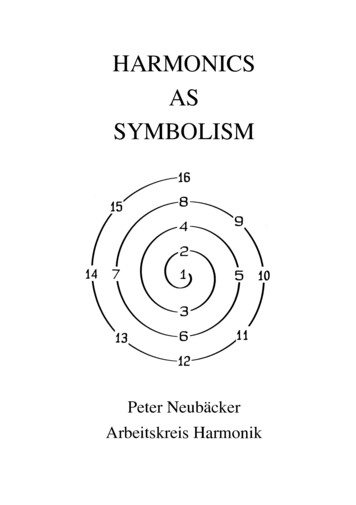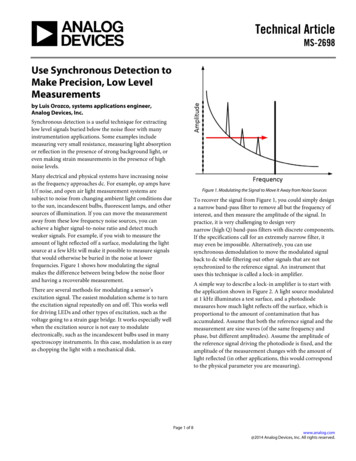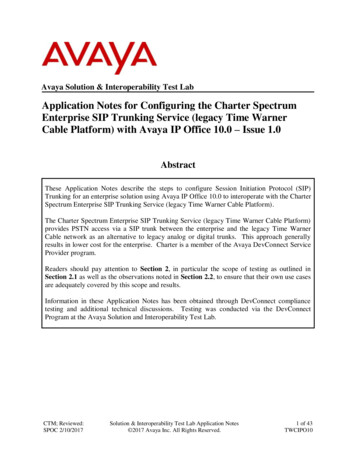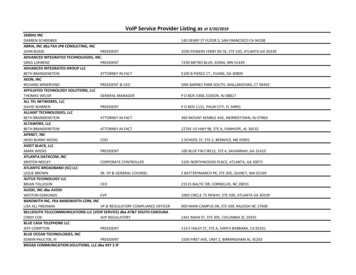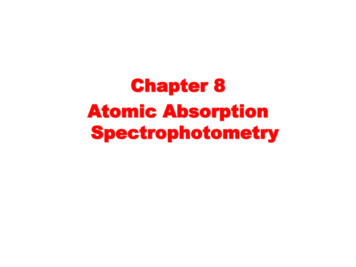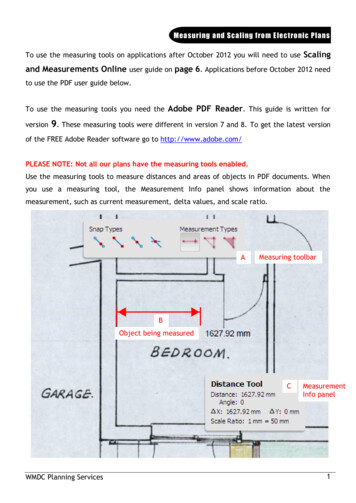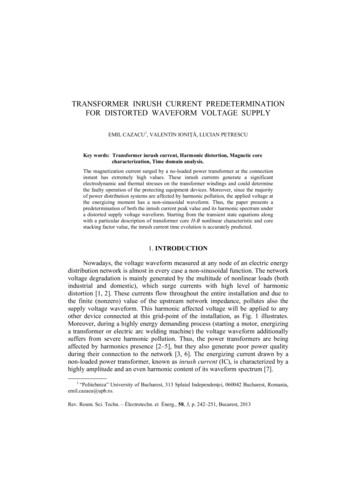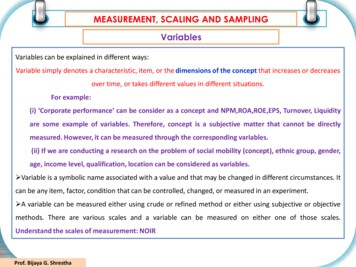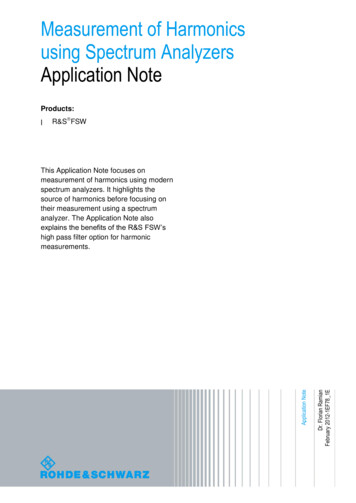
Transcription
Measurement of Harmonicsusing Spectrum AnalyzersApplication NoteProducts: R&S FSWDr. Florian RamianFebruary 2012-1EF78 1EApplication NoteThis Application Note focuses onmeasurement of harmonics using modernspectrum analyzers. It highlights thesource of harmonics before focusing ontheir measurement using a spectrumanalyzer. The Application Note alsoexplains the benefits of the R&S FSW’shigh pass filter option for harmonicmeasurements.
Table of ContentsTable of Contents1EF78 2E1Introduction . 32Harmonics. 32.1Theory of Harmonic Signals .32.2Specification of Harmonics .43Measurement of Harmonics . 53.1Spectrum analyzer design minimizing harmonics.63.1.1Harmonics in the microwave range .63.1.2Harmonics below the microwave range .73.2Differentiating between DUT generated and analyzer generatedharmonics .84Conclusion. 115Literature. 126Ordering Information . 12Rohde & SchwarzHarmonic Measurements on Modern Spectrum Analyzers 2
IntroductionTheory of Harmonic Signals1 IntroductionOne of the key features of non-linear elements in any electronic circuit is thegeneration of harmonic signals. On the one hand side, harmonics resulting from thenon-linear characteristic of a given component like a diode, are used intentionally toimplement vital functions for today’s RF world, such as e.g. harmonic mixers. On theother hand, not every harmonic signal generated by a DUT may be welcome. In anideal world, amplifiers do not generate any harmonics, but simply amplify the inputsignal. One of the challenges in the real world therefore is to optimize a device to comeas close as possible to its ideal, which means to make use of the wanted harmonicsrdnd(e.g. of 3 order) and suppress the unwanted harmonics (e.g. of 2 order).When it comes to measuring the harmonics of a device, not only the device under test(DUT) consists of non-linear elements. The measuring instrument - usually a spectrumanalyzer – contains amplifiers and mixers, which also may generate harmonics andthus contribute to the measurement results. During the verification of the harmonicspecifications of a DUT, extra effort therefore is necessary to differentiate harmonicsgenerated by the DUT from harmonics generated by the measuring instrument.This article briefly derives the generation of harmonics in non-linear elements, beforehighlighting the architecture of the high-end spectrum analyzer R&S FSW. The R&SFSW was designed to minimize internally generated harmonics to provide outstandingharmonic measurement performance.2 Harmonics2.1 Theory of Harmonic SignalsThis chapter gives some mathematical background on the origin and behavior ofharmonic signals. Readers who are familiar with the theory of Taylor series arewelcome to skip this chapter and continue directly with chapter 2.2.Harmonics, no matter of which order, are generated every time when a signal withfrequency f 0 passes through a non-linear component.The output signal of a component can be derived from the input signal using a socalled transfer function, which provides a mathematical relation between the twosignals. As known from mathematical theory, every transfer function can be describedby a polynomial, a so-called Taylor-series.Without going into details on how to calculate the individual coefficients an, this meansthat the behavior of any non-linear component can be described by a formula likeP s a0 a1 s a2 s 2 a3 s 3 with P(s) being its transfer function and s being the input signal.Assuming a CW input signal, the general formula for a signal s as a function of time t iss t B cos 2 f t .In the output signal of the element the input signal appears within the termis generally known as the fundamental signal.The addition theorem for the cosine function1EF78 2Ea1 s , whichRohde & SchwarzHarmonic Measurements on Modern Spectrum Analyzers 3
HarmonicsSpecification of Harmonicscos cos 1 cos cos 232can be applied to the terms a 2 s , a3 s etc., with α and β being replaced by2 f t .2For s (t) this results in a terms 2 (t ) 1 2 B cos 2 (2 f ) t 2 1 2which is a signal with twice the frequency of the original CW signal, the so-called 2harmonic.3For s (t) the resulting term iss 3 (t ) nd1 3 B cos 2 (3 f ) t 3 3 cos 2 f t 4rdwhich includes a term with 3 times the frequency of the CW signal, the 3 harmonic.nGenerally speaking the term s (t) will include a term with n-times the frequency of thethoriginal CW signal, the n harmonic.The above equations lead to two basic conclusions:1. Since a Taylor-series is infinite, the number of harmonics included in theoutput signal is also infinite in theory.In practice, higher order harmonics (e.g. n 10) can usually be ignored,because the amplitude of the signal decreases with increasing order of thendharmonic: the factor from the addition theorem ( ½ for the 2 harmonic, ¼ forrdthe 3 harmonic etc.), or generally speaking, the n-th coefficient an, decreaseswith the order of n.2. When decreasing the amplitude of the CW signal, the amplitude of thenharmonic signals decreases exponentially, as expressed by the factor B .Practically on a logarithmic scale 1 dB less power of the fundamental meansrd2 dB less of second order harmonic, 3 dB less of 3 order, and so on.2.2 Specification of HarmonicsIn technical specifications, harmonics are often specified using the so-called harmonicintercept point. The intercept point specifies a theoretical point, where a certainharmonic, e.g. the second for the second harmonic intercept, has grown as large asthe fundamental itself. The intercept point is a theoretical point, because in real-life,non-linear effects, such as e.g. saturation, usually dominate before the intercept pointis reached.From the equations in chapter 2.1, the level difference between fundamental andharmonic signal can be calculated for any given level of the fundamental if the interceptndpoint is known. As an example, a 2 order harmonic intercept point of 80 dBm is given.ndThe level difference between fundamental and 2harmonic distortion for andfundamental of 20 dBm is 60 dB, i.e. the 2 harmonic level is -40 dBm in this case.This example corresponds to the graph in Figure 1. In short, the distance betweenndfundamental and second harmonic D2 for a given level P1 can be calculated from a 2order harmonic intercept point SHI as follows:D2 SHI P1Note that the calculation is valid only for a logarithmic scale, i.e. D2 is in dBc, P1 andSHI in dBm.1EF78 2ERohde & SchwarzHarmonic Measurements on Modern Spectrum Analyzers 4
Measurement of HarmonicsSpecification of HarmonicsPlease note that the specification of the second (or higher) harmonic intercept differsfrom the intermodulation intercept points, called IP2, or IP3. The harmonic interceptsare measured in a single tone scenario, whereas the intermodulation intercept pointsare measured with in a two tone scenario. This application note focuses on harmonicsof a single tone input signal. Therefore, the intersection with the third harmonic inFigure 1 is not marked, as the third harmonic intercept point (THI) is not common. Insome documents, the harmonic intercepts are also abbreviated IPk2 or IPk3, with anadditional “k” differentiating it from the intermodulation intercepts. The IP2 is always6 dB below the SHI (IPk2), whereas the IP3 is 9.54 dB below the THI (IPk3) [Rau01].rdNevertheless there is a similar equation for the 3 order harmonic distortion D3 for ardgiven level P1, derived from the intersect point of the 3 order harmonic distortion withP1:D3 2 (THI P1 )ndrdFigure 1 shows fundamental and harmonic distortion of 2 and 3 order for a nonlinear 2-port with gain 1. The intercept point of second order is indicated at 80 dBm.Figure 1: Input and output levels of a non-linear element with gain 1, for fundamental, 2nd and 3rdharmonics, single tone scenario3 Measurement of HarmonicsTo measure the harmonic signals of a DUT, a frequency selective measuringinstrument is necessary to separate the fundamental from the harmonic signals. Toavoid complicated setups of filters and power meters, harmonics are usually measuredusing spectrum analyzers. Spectrum analyzers are capable of displaying thefundamental signal and its harmonics at the same time – depending on the frequencyrange of the analyzer.1EF78 2ERohde & SchwarzHarmonic Measurements on Modern Spectrum Analyzers 5
Measurement of HarmonicsSpectrum analyzer design minimizing harmonics3.1 Spectrum analyzer design minimizing harmonicsSpectrum analyzers have different operating concepts, depending on the frequencyrange. The so-called RF path (path “1” in Figure 2) is used for frequencies e.g. up to3.6 GHz, 7 GHz, or 8 GHz, depending on the spectrum analyzer model. Above thisfrequency limit (path “2”), a tunable preselection filter, in most cases using YIGtechnology (Yttrium Iron Garnet) is applied for image frequency rejection. [Rau01]discusses the details on spectrum analyzer design concepts.As the frequency range of path “2” usually extends to 13 GHz and above, path "2" isoften called the "microwave path". The R&S FSW switches from path “1” to path “2” at8 GHz. For the following two sections, it is important to keep in mind that the criticalelement, creating the strongest harmonics, is the first mixer (non-linear element) in thesignal path. This mixer is either the up-converting mixer to IF1 for path “1”, or thedown-converting mixer to IF2 for path “2”. The subsequent mixers in the block diagramin Figure 2 do not contribute to the harmonic distortion, since they are operated asfixed frequency mixers (LO has always the same frequency), followed by band passfilters which block their harmonics.The difference in terms of harmonics between the RF and the microwave signal path isthe YIG filter in front of the first non-linear element in the signal flow.1R ILRLIRIF1 FilterRF attenuation0 – 70 dBLIF2 FilterLO1LO2RLYIGPreselectorADCIIF3 FilterLO3I2LOFigure 2: Simplified block diagram of a heterodyne spectrum analyzer, with RF path “1”, andmicrowave path “2”3.1.1 Harmonics in the microwave rangeAs mentioned above, a tunable preselection filter is utilized for image frequencyrejection in the microwave band. It is swept or tuned across the frequency range ofinterest and allows only a small band of frequencies to pass onto the mixer. The typicalbandwidth of preselection filters is on the order of 30 MHz to 50 MHz.For measurement of harmonic signals the YIG preselection filter is an advantage forthe microwave signal path. When measuring harmonic distortion at 8 GHz or abovewith a 30 MHz band pass filter, the fundamental at e.g. 4 GHz will be suppressed bythe filter and can therefore not create any harmonic signals. Practically speaking, if thespectrum analyzer is tuned to measure harmonic power at 8 GHz, the fundamentalsignal at the RF input port (4 GHz) does not reach a non-linear element, because theYIG preselector rejects it. Thus, the contribution of the spectrum analyzer to themeasured harmonic power is negligible.1EF78 2ERohde & SchwarzHarmonic Measurements on Modern Spectrum Analyzers 6
Measurement of HarmonicsSpectrum analyzer design minimizing harmonics3.1.2 Harmonics below the microwave rangeIn contrast to the microwave signal path, the RF signal path of a spectrum analyzerusually does not have a tunable preselection filter. Consequently this means thatwithout further precautions the signal power of the entire frequency band (e.g. DC to8 GHz) will be applied to the first mixer. Assuming a CW input signal of 1.2 GHz, thefirst mixer in path “1” (Figure 2) also "sees" the 1.2 GHz signal when measuring thepower at the harmonic frequency of 2.4 GHz. Therefore the harmonics created insidethe mixer will be displayed on the analyzer screen as part of the measured signalpower.In order to optimize the performance in the RF frequency range, the R&S FSW usesseveral signal paths, each of them optimized for best performance within its frequencyrange.In terms of harmonic measurements, an ideal spectrum analyzer would be equippedwith a separate path for every octave, so that the fundamental and the harmonicsignals always pass through different signal paths. Even though this looks like astraightforward concept, the number of switching points has a direct impact on thesweep speed, since every switching point costs additional settling time before themeasurement can be continued. As in practice the "one octave per path" conceptcannot be maintained for low frequencies, the R&S FSW starts to use it at 350 MHz.Figure 3 shows the preselection concept of the R&S FSW for frequencies below8 GHz. In the diagram, all parallel paths for the different frequency ranges arenumbered from “1” through “5”. The signal flow chart is simplified, but contains allsignificant filters of the preselection concept.Preselector (on Frontend)High pass5 - 8 GHzfg 8 GHz5To 8 GHzconverterBand pass3 - 5.5 GHz4fg 8 GHz3RF InputLow pass3.5 GHzHigh pass 1.7 GHz -25 dB at 1.5 GHz3aHigh pass 1GHz -25 dB at 900MHz2fg 600 M3bOption high pass filterLow pass1.1 GHzTo 1 GHz converterHigh pass 0.5 GHz1ADC direct(DC to 80 MHz)Figure 3: Signal Flow for f 8 GHzIn Figure 3, signal paths “1”, “4”, and “5” each comprise less than an octave. Thefrequency range limitation of each path is defined by low pass or high pass filters, asshown in the figure.1EF78 2ERohde & SchwarzHarmonic Measurements on Modern Spectrum Analyzers 7
Measurement of HarmonicsDifferentiating between DUT generated and analyzer generated harmonicsSignal path "2" is used for frequencies 600 MHz. As discussed above, the concept toseparate fundamental and harmonic, does not apply for this path.Signal path “3” from 1 GHz to around 3.5 GHz requires special attention, as it coversthe most popular frequencies for mobile communication standards, such as GSM,WCDMA, or LTE. Without additional measures this signal path will cover more thanone octave.By adding two different high pass filters, option R&S FSW-B13 "High pass filter forharmonic measurements", splits signal path "3" into two paths, “3a” and “3b”, whichnow comprise less than one octave each. Option B13 increases the second harmonicintercept point of the R&S FSW from 47 dBm (without option B13) to 62 dBm forfundamental frequencies in the range between 500 MHz and 1500 MHz.The additional high pass filters added by option B13 can be activated on demand. Indefault operation (filters off) the R&S FSW provides maximum sweep speed, inharmonic suppression mode (filters on) the R&S FSW provides optimum harmonicdistortion performance.3.2 Differentiating between DUT generated and analyzergenerated harmonicsDuring harmonic measurements, it is essential to make sure that the measuredharmonic signals are generated by the DUT and not caused by the measuringinstrument.As already mentioned, the first mixer will cause a major part of the harmonic distortioncontributed by the spectrum analyzer. This part of the distortion depends on the powerthe mixer “sees”, and is therefore influenced by the RF attenuation applied to thesignal. Adding RF attenuation at the analyzer input will therefore reduce its residualharmonic distortion.The harmonic distortion part coming from the DUT is independent of the level at thefirst mixer of the spectrum analyzer. Adding RF attenuation will have no influence onthe level distance between fundamental and harmonic signal of the DUT.This difference in behavior can be used to minimize the harmonic distortioncontribution of the spectrum analyzer: By increasing the RF attenuation, the harmonicstsignals created by the 1 mixer will decrease, whereas the external harmonic signalswill not change in level on the display, as the spectrum analyzer compensates for theadditional attenuation applied to them by shifting their signal level numerically. Thesignal flow in Figure 4 shows this compensation mechanism:Signal withpower PRF Attenuator,PMixer P - RFAttattenuation RFAttDownconverter(1st Mixer)Displayed power:P PMixer RFAttFigure 4: Signal Power Flow Chart through a Spectrum Analyzer, with signal power P, RF attenuationsetting RFAtt, signal power at mixer PMixer, and displayed Power P ( signal power)1EF78 2ERohde & SchwarzHarmonic Measurements on Modern Spectrum Analyzers 8
Measurement of HarmonicsDifferentiating between DUT generated and analyzer generated harmonicsAs an example, a CW signal at -10 dBm is assumed, with an initial attenuator setting ofnd0 dB. It is also assumed that the spectrum analyzer in use displays an inherent 2harmonic at -40 dBm. Increasing the attenuator setting to 10 dB still displays thefundamental at -10 dBm. Assuming an ideal DUT with no harmonics generated, thendstdisplay of the 2 harmonic caused by the 1 mixer of the spectrum analyzer willdecrease by approx. 10 dB.Due to this behavior, it is easy to differentiate between DUT generated harmonics andanalyzer generated ones by using the variable RF attenuator of the spectrum analyzer.In Figure 5 marker M2 shows the level of the harmonic signal with 0 dB attenuation,whereas marker M3 shows its level with 10 dB attenuation applied. The level differenceis obvious, which means that a significant part of the harmonic power with 0 dBattenuation was generated by the spectrum analyzer.Figure 5: Fundamental and second harmonic, black trace with 10 dB RF attenuation, blue trace with 0dB. The lower diagram shows the zoomed area around the 2nd harmonicIn the scenario used for Figure 5, the additional high pass filters of the R&S FSW-B13option exhibit their full benefit. They provide a harmonic suppression for the givenscenario of more than 20 dB, as shown in Figure 6, without having to increase the RFattenuation.1EF78 2ERohde & SchwarzHarmonic Measurements on Modern Spectrum Analyzers 9
Measurement of HarmonicsDifferentiating between DUT generated and analyzer generated harmonicsFigure 6: Fundamental and second harmonic, black trace with High Pass Filters Off, blue trace withHigh Pass Filters On, same RF attenuation. The lower diagram shows the zoomed area around the 2ndharmonic.Other than in Figure 5, the noise floor does not increase, since no additionalattenuation is used. A closer look even reveals a slightly lower noise floor, due toadditional amplifiers in the high pass filter path. Clearly, using the high pass filtersinstead of additional attenuation allows more sensitive harmonic measurements whenusing the R&S FSW.Figure 7 shows the Input Source Dialog (INPUT/OUTPUT – Input Source Config) usedto activate the R&S FSW-B13 high pass filters.Figure 7: Input Source Dialog providing the High Pass Filter On/Off selection1EF78 2ERohde & SchwarzHarmonic Measurements on Modern Spectrum Analyzers 10
ConclusionDifferentiating between DUT generated and analyzer generated harmonics4 ConclusionWhenever it gets to measuring harmonics on a spectrum analyzer, it is important tomake sure that the DUT generated harmonics clearly dominate.Increasing the RF attenuator setting is an appropriate way to minimize the analyzergenerated harmonics at the cost of an increased noise floor, which means lesssensitivity for the measurement.The R&S FSW uses a design concept with high pass filters in the RF signal path up to8 GHz, which minimizes the contribution of spectrum analyzer inherent harmonicsignals. For harmonic measurements in the range from 1 GHz to 3.5 GHz option R&SFSW-B13 adds two more high pass filters, which allow harmonic measurements oncellular signals without sacrificing sensitivity.1EF78 2ERohde & SchwarzHarmonic Measurements on Modern Spectrum Analyzers 11
LiteratureDifferentiating between DUT generated and analyzer generated harmonics5 Literaturest[Rau01]Rauscher, Christoph. Fundamentals of Spectrum Analysis. 1 edition.Rohde & Schwarz.6 Ordering Information1EF78 2ER&S FSW8Signal- and Spectrum analyzer 2 Hz to 8 GHz1312.8000.08R&S FSW13Signal- and Spectrum analyzer 2 Hz to 13.6 GHz1312.8000.13R&S FSW26Signal- and Spectrum analyzer 2 Hz to 26.5 GHz1312.8000.26R&S FSW-B13High pass filter for harmonic measurements1313.0761.02Rohde & SchwarzHarmonic Measurements on Modern Spectrum Analyzers 12
About Rohde & SchwarzRohde & Schwarz is an independent groupof companies specializing in electronics. It isa leading supplier of solutions in the fields oftest and measurement, broadcasting,radiomonitoring and radiolocation, as well assecure communications. Established morethan 75 years ago, Rohde & Schwarz has aglobal presence and a dedicated servicenetwork in over 70 countries. Companyheadquarters are in Munich, Germany.Environmental commitment Energy-efficient products Continuous improvement inenvironmental sustainability ISO 14001-certified environmentalmanagement systemRegional contactEurope, Africa, Middle East 49 89 4129 12345customersupport@rohde-schwarz.comNorth America1-888-TEST-RSA .comLatin America Asia/Pacific 65 65 13 04 88customersupport.asia@rohde-schwarz.comThis application note and the suppliedprograms may only be used subject to theconditions of use set forth in the downloadarea of the Rohde & Schwarz website.R&S is a registered trademark of Rohde & SchwarzGmbH & Co. KG; Trade names are trademarks of theowners.Rohde & Schwarz GmbH & Co. KGMühldorfstraße 15 D - 81671 MünchenPhone 49 89 4129 - 0 Fax 49 89 4129 – 13777www.rohde-schwarz.com
In the output signal of the element the input signal appears within the term a 1 s, which is generally known as the fundamental signal. The addition theorem for the cosine function . Harmonics . The so-called RF path (path "1" in Figure 2) is used for frequencies e.g. up to 3.6 GHz, 7 GHz, or 8 GHz, depending on the spectrum analyzer .
